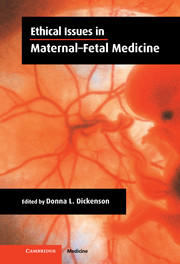Book contents
- Frontmatter
- Contents
- List of contributors
- Acknowledgements
- 1 Introduction: recent debates in maternal–fetal medicine – what are the ethical questions?
- 2 Overview: a framework for reproductive ethics
- I GENERIC ISSUES IN PREGNANCY
- II INCEPTION OF PREGNANCY: NEW REPRODUCTIVE TECHNOLOGIES
- 9 Ethical issues in embryo interventions and cloning
- 10 A case-study in IVF: paternalism and autonomy in a ‘high-risk’ pregnancy
- 11 The ethics of secrecy in donor insemination
- III FIRST AND SECOND TRIMESTER
- IV THIRD TRIMESTER
- V NEONATAL LIFE
- Index
11 - The ethics of secrecy in donor insemination
from II - INCEPTION OF PREGNANCY: NEW REPRODUCTIVE TECHNOLOGIES
Published online by Cambridge University Press: 29 September 2009
- Frontmatter
- Contents
- List of contributors
- Acknowledgements
- 1 Introduction: recent debates in maternal–fetal medicine – what are the ethical questions?
- 2 Overview: a framework for reproductive ethics
- I GENERIC ISSUES IN PREGNANCY
- II INCEPTION OF PREGNANCY: NEW REPRODUCTIVE TECHNOLOGIES
- 9 Ethical issues in embryo interventions and cloning
- 10 A case-study in IVF: paternalism and autonomy in a ‘high-risk’ pregnancy
- 11 The ethics of secrecy in donor insemination
- III FIRST AND SECOND TRIMESTER
- IV THIRD TRIMESTER
- V NEONATAL LIFE
- Index
Summary
Secrecy has been an integral part of donor insemination (DI) since its beginning (reputedly in 1884) (Daniels and Haimes, 1998). Recently attention has been given to the possible adverse effects of secrecy and, accordingly, the practice of secrecy in DI has been questioned. This chapter will attempt to analyse the reasons that have been given for and against secrecy and will consider the effect which changing the practices of secrecy might have on DI.
Introduction
Many explanations have been put forward for continuing the practice of secrecy in DI. These justifications range from patient confidentiality to social reasons such as the stigma attached to illegitimacy. The supposed stigma of illegitimacy is now vastly reduced to the point of being negligible, as are other historical reasons, such as those cited by Pfeffer (1993), namely the stigmas of adultery and masturbation. Such reasons cannot be regarded as major factors, though they may continue to carry some weight in certain social groups. Secrecy has become, either through time or design, not simply an addendum to DI but part of the structure of the procedure (Nachtigall, 1993). The integral part which secrecy has played in DI makes exploration and analysis of this topic difficult. Not only is DI less in the public eye, and so less discussed than other assisted reproductive technologies; secrecy also ‘covers its own tracks’, in that little evidence exists regarding the effects of secrecy on families who have used DI to conceive.
- Type
- Chapter
- Information
- Ethical Issues in Maternal-Fetal Medicine , pp. 167 - 180Publisher: Cambridge University PressPrint publication year: 2002
- 1
- Cited by

